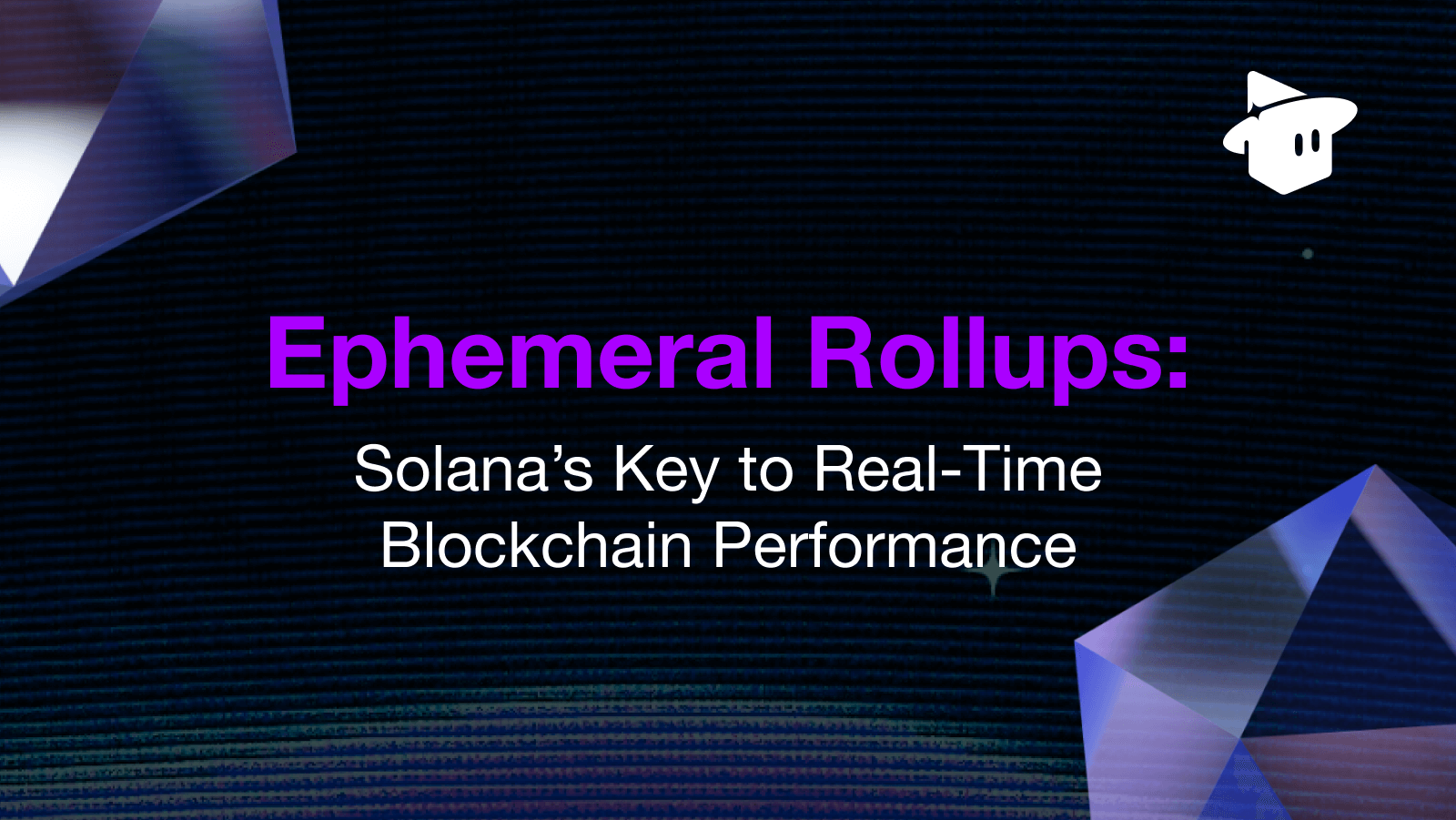
Ephemeral Rollups: Solana’s Key to Real-Time Blockchain Performance


Why Scaling Still Hurts
Every blockchain promises scale. But when you’re actually building, you hit the same walls: latency, high fees, and congestion. Transactions wait in public mempools, giving bots the chance to front-run and manipulate orderflow. For DeFi traders, that means worse execution. For gamers, it means lag that kills immersion.
The reason comes down to the mechanics of traditional rollups. Both optimistic and ZK rollups were designed to cut costs, but their architectures introduce delays that make true real-time execution impossible.
Traditional Rollups in a Nutshell
Optimistic Rollups
Optimistic rollups assume all transactions are valid, but they add a fraud-proof window, often 7 days, in case of disputes. It’s great for reducing costs, but not great for instant liquidity. Imagine trying to trade or game with a one-week withdrawal delay; the UX simply breaks.
ZK Rollups
Zero-knowledge (ZK) rollups bring stronger cryptography. They batch transactions and prove validity with SNARKs or STARKs. This shortens finality compared to optimistic rollups, but generating proofs is computationally heavy. For apps needing split-second responsiveness, ZK still isn’t enough.ZK rollups face computational overhead that can limit sub-100ms UX in many setups.
Traditional rollups, whether optimistic or ZK, are still Layer 2 bolt-ons. They require bridges, challenge windows, and their own tokens. For developers, this means added complexity. For users, it means friction.
The Layer 2 Trade-Off
Whether optimistic or ZK, traditional Layer 2 scaling solutions remain bolt-ons to Ethereum’s Layer 1. They require bridges, challenge windows, and in many cases, their own tokens. For developers, this adds complexity. For users, it creates friction. The Layer 2 vs Layer 1 trade-off has always been speed and flexibility on one side, with latency and fragmentation on the other. But Solana takes a different path.
How Solana Scales Today
Solana scaling starts from the base layer. As a high-performance L1, it’s built with parallel execution (Sealevel), local fee markets, and Proof of History to maximize consensus efficiency. This protocol design lets Solana process thousands of TPS with sub-second finality, a scale that’s already live, not theoretical.
Unlike Ethereum scaling, on Solana there’s no need for zk or optimistic rollups to achieve throughput. What apps like auctions, high-frequency DeFi, or gaming truly demand is low-latency, low-cost, private execution. That’s where Ephemeral Rollups help in enabling truly real-time Solana apps.
Solana’s throughput isn’t theoretical; it’s built into its validator design. Each validator runs multiple concurrent transactions through Sealevel, coordinated by a rotating leader schedule that defines block production order. This setup, paired with local fee markets, minimizes congestion and keeps fees predictable. Because execution is parallelized, applications already benefit from sub-second block finality without the need for separate rollups or challenge windows.
Enter Ephemeral Rollups
Ephemeral Rollups give developers dedicated execution environments tuned for their app’s needs. They improve latency, lower costs, and in the case of TEE-based ERs, provide private execution.
What makes Ephemeral Rollups distinct isn’t just their speed, but how they tie back to Solana’s existing validator and state model. Each rollup operates as a dedicated runtime instance that executes transactions locally, then commits the resulting state transitions back to Solana’s L1 for finalization and consensus security. This lets developers gain ultra-low latency without introducing new trust assumptions or bridge complexity.
Think of them as temporary rollups, or app-specific fast lanes. A DeFi app, game, or NFT project can spin up its own rollup for real-time responsiveness. Transactions are executed instantly in isolation, then settled back onto Solana for security.
These Solana rollups are:
- Low-latency: Millisecond-level responsiveness.
- Cost-efficient: Optimized for throughput.
- Private (TEE ERs): Confidential orderflow secured by Trusted Execution Environments, which ensure transactions are executed privately and verifiably before settlement.
- Flexible: Developers control their own environment.
As stateless rollups, they balance on-chain vs off-chain computation for efficiency. These Solana rollups represent a next-gen blockchain architecture, and MagicBlock is pioneering them for real-time scaling.
How They Stack Up
Ephemeral Rollups Vs Traditional Rollups
Traditional rollups improved scalability, but real-time speed remains out of reach. Fraud proofs and validity proofs protect security, but introduce settlement delays. Batching boosts throughput, yet transactions still wait before confirmation. Ephemeral Rollups shift the focus: they isolate execution for instant responsiveness, while relying on Solana’s base layer for security. The result is a user experience that feels truly real-time.
Ephemeral Rollups Vs Batchers & App Chains
Batchers can reduce transaction costs, but they still compete in shared ordering systems and can’t guarantee low latency. App chains give developers full control, but often require bootstrapping new validators, issuing tokens, and dealing with fragmented liquidity. Ephemeral Rollups strike the balance: offering app-specific execution environments with the efficiency of batching, without the operational overhead of running a separate chain. And because they settle back to Solana, they inherit its throughput and security.
Why Latency & Orderflow Matter
In finance and gaming, milliseconds change outcomes. On-chain, the problem isn’t just waiting 400ms,it’s how transactions can be reordered within a block, letting validators or bots extract MEV and turning profitable trades into losses. For gamers, even small delays break immersion. Traditional rollups reduce costs but fragment liquidity and add friction, limiting real-time experiences. Ephemeral Rollups address this by giving apps dedicated execution with lower latency, reduced costs, and, in TEE setups, private orderflow. From high-frequency trading on blockchain to DeFi scaling solutions, this unlocks real-time settlement that finally feels seamless.
Real-World Example: Faster DeFi Trades
On an Ethereum optimistic rollup, trades hit the mempool and get exposed to MEV bots that reorder for profit, causing worse pricing and slippage. On Solana, there’s no global mempool, but block leaders can still reorder transactions. Different mechanics, same outcome: users lose.
With an Ephemeral Rollup on Solana, the same swap executes instantly. Transactions are sequenced first-come, first-served, and because the rollup operator controls the node, trades aren’t reordered. That’s why MEV isn’t a factor here, users get fair execution by design. Settlement happens seamlessly in the background, delivering one of the most efficient DeFi scaling solutions to date.
This same logic applies to gaming or NFT minting scalability. On Ethereum Rollups you click and wait. On Ephemeral Rollups, execution feels immediate, Web2 speed, Web3 trust.
Why Solana’s Approach Wins
Solana already delivers high throughput and low latency as a high-performance L1, built on parallel execution, local fee markets, and strong consensus efficiency. It doesn’t rely on external rollups for scale. That’s baked into its protocol design.
Ephemeral Rollups extend this foundation. By giving developers dedicated, private execution environments, they add “burst capacity” for apps that demand real-time performance.
For builders, that means:
- No bridges or separate tokens.
- Developer-friendly scaling for real-time UX.
- Infrastructure for dApps across DeFi, gaming, and beyond.
Ephemeral Rollups expand Solana’s scaling, unlocking real-time apps that actually work.
The Bottom Line
Traditional rollups pushed scalability forward, but they never solved latency or orderflow. Solana already solved throughput at the base layer with parallel execution and consensus efficiency. Ephemeral Rollups extend that power by delivering instant, private, app-specific execution for real-time apps.
For developers, it’s a massive advantage. For investors, it signals a new category in blockchain infrastructure. And for users, it simply feels better: real-time trades, real-time games, real-time blockchain and MagicBlock is the team bringing it to life.





